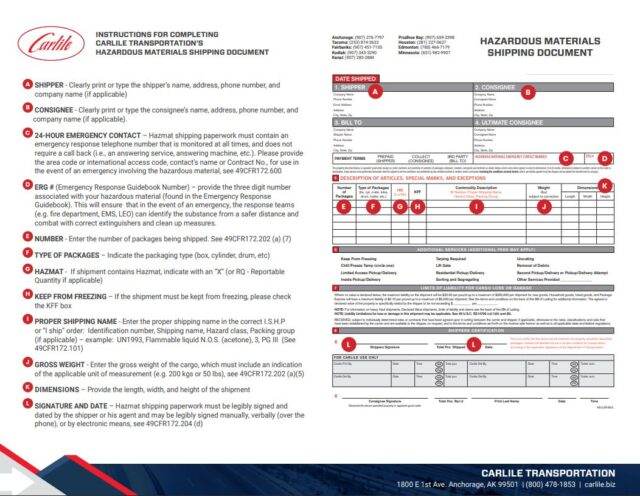Table of Contents
- Introduction
- Shipper and Consignee Information
- Freight Forwarder and Carrier Information
- Date of Shipment
- Purchase Order or Reference Number
- Description of Goods
- Harmonized System (HS) Codes
- Shipping Terms and Freight Payment Terms
- Special Instructions or Handling Requirements
- Signature and Date
- Declaration of Value
- Frequently Asked Questions
- Conclusion
- Key Takeaways
Navigating the world of freight transportation can be a complex task, especially when dealing with the intricacies of paperwork like the Bill of Lading. This document is a cornerstone of the shipping industry, acting as a contract between the shipper and carrier, a receipt of goods, and a document of title. Its importance cannot be overstated, as it ensures the smooth operation of the supply chain and protects all parties involved in the shipping process.
1. Shipper and Consignee Information:
The first crucial elements on any Bill of Lading are the names and addresses of the shipper and consignee. These details are vital for the smooth shipping of goods, as they determine the origin and destination of the shipment. Inaccurate or incomplete information can lead to delays or misdelivery, disrupting the entire shipping process. Therefore, it’s essential to double-check these details for accuracy.
2. Freight Forwarder and Carrier Information:
Next, the names and addresses of the freight forwarder and carrier should be clearly stated. Clear communication between all parties involved is key to a successful shipping process. This information ensures that all parties are aware of their roles and responsibilities, reducing the chances of misunderstandings or disputes.
3. Date of Shipment:
The date the shipment leaves the shipper’s facility is another essential detail. This information is crucial for tracking purposes and setting delivery expectations. It allows all parties to monitor the progress of the shipment and plan accordingly.
4. Purchase Order or Reference Number:
The shipper’s and consignee’s purchase order or reference numbers are vital for easily identifying the shipment. These numbers serve as unique identifiers for the shipment, facilitating proper documentation and cargo tracking.
5. Description of Goods:
The Bill of Lading should include a detailed description of the shipped goods, including type, quantity, and packaging. This information is significant for customs clearance and transportation requirements, ensuring that the goods are handled and transported correctly.
6. Harmonized System (HS) Codes:
Applicable HS codes for the shipped goods should also be included. These codes are used for customs classification and proper duty assessment, making them crucial for the customs clearance process.
7. Shipping Terms and Freight Payment Terms:
The Incoterms and payment terms for the shipment should be clearly stated. These terms clarify the responsibilities and costs between the shipper and consignee, ensuring that both parties understand their obligations.
8. Special Instructions or Handling Requirements:
Any special handling instructions or requirements for the shipped goods should be included. This information is crucial for ensuring proper care and handling during transportation, especially for fragile or hazardous goods.
9. Signature and Date:
The Bill of Lading should be signed and dated by the shipper, carrier, and freight forwarder (if applicable) to confirm the accuracy of the information. These signatures have legal significance, serving as proof of agreement between all parties.
10. Declaration of Value:
Finally, the declared value of the goods being shipped should be stated. This information is relevant for insurance purposes and potential liability in case of loss or damage. It ensures that the goods are adequately covered in the event of any mishaps during transportation.
Frequently Asked Questions
How do you fill out a bill of lading?
Filling out a Bill of Lading (BOL) involves several steps, each corresponding to the essential elements we discussed earlier. Here’s a step-by-step guide:
Shipper and Consignee Information: Start by entering the names and addresses of the shipper (the party sending the goods) and the consignee (the party receiving the goods). Make sure this information is accurate to prevent any shipping errors.
Freight Forwarder and Carrier Information: Next, provide the names and addresses of the freight forwarder (if applicable) and the carrier (the party transporting the goods). This information ensures that all parties involved in the shipping process are properly identified.
Date of Shipment: Indicate the date the shipment is expected to leave the shipper’s facility. This information is crucial for tracking and delivery purposes.
Purchase Order or Reference Number: Enter the shipper’s and consignee’s purchase order or reference numbers. These numbers serve as unique identifiers for the shipment, facilitating easier tracking and documentation.
Description of Goods: Provide a detailed description of the goods being shipped, including their type, quantity, and packaging. This information is necessary for customs clearance and transportation requirements.
Harmonized System (HS) Codes: Include the applicable HS codes for shipped goods. These codes are used for customs classification and duty assessment.
Shipping Terms and Freight Payment Terms: Clearly state the Incoterms and payment terms for the shipment. These terms clarify the responsibilities and costs between the shipper and the consignee.
Special Instructions or Handling Requirements: If the goods require any special handling instructions or have specific requirements, make sure to include this information. This ensures the goods are handled and transported correctly.
Signature and Date: The BOL should be signed and dated by the shipper, carrier, and freight forwarder (if applicable). These signatures confirm the accuracy of the information and serve as a legal agreement between all parties.
Declaration of Value: State the declared value of the shipped goods. This information is important for insurance purposes and potential liability in case of loss or damage.
Download Carlile’s Instructions for Completing a Hazmat BOL Below.
If you’re unsure about any aspect of filling out a BOL, it’s always a good idea to seek advice from a shipping or logistics expert.
Is a bill of lading a legal document?
A Bill of Lading (BOL) is a legal document. It serves three main purposes in the field of shipping and freight transportation:
- Contract of Carriage: The BOL acts as a contract between the shipper and the carrier. It outlines the terms and conditions under which the goods will be transported, including details about the goods, the agreed route, and the freight charges.
- Receipt of Goods: When the carrier picks up the goods from the shipper, they provide a signed BOL as a receipt. This confirms that they have received the goods in the stated condition and are committed to delivering them as per the contract.
- Document of Title: A BOL can also act as a document of title, providing proof of ownership of the goods. This is particularly important in transactions where ownership of the goods changes hands during transit, such as in ‘To Order’ shipments.
Given these roles, any inaccuracies or discrepancies in a BOL can lead to legal disputes. Therefore, it’s crucial to ensure that all information on a BOL is accurate and complete.
In conclusion, these are the top 10 essential elements to include on a Bill of Lading. Ensuring that these details are accurate and complete can significantly streamline the shipping process, reducing the chances of delays or complications. For your Alaskan shipping needs, choose Carlile. With our expertise in handling shipping documentation and logistics, we can help make your shipping experience as smooth as possible.
Key Takeaways
- Importance of the Bill of Lading: The Bill of Lading (BOL) is a crucial document in the shipping industry, serving as a contract of carriage, a receipt of goods, and a document of title. It ensures smooth operations and protects all parties involved in the shipping process.
- Essential Elements: The BOL should include accurate and complete information about the shipper, consignee, freight forwarder, carrier, shipment date, purchase order or reference number, description of goods, HS codes, shipping and payment terms, special instructions, signatures, and declared value of goods.
- Filling Out a BOL: Each section of the BOL corresponds to an essential element and should be filled out carefully and accurately. Any inaccuracies can lead to legal disputes or shipping errors.
- Legal Significance: The BOL is a legal document that can lead to legal disputes if not handled correctly. It’s crucial to ensure all information is accurate and complete.
- Expertise Matters: For your Alaskan shipping needs, consider choosing a company with expertise in handling shipping documentation and logistics, like Carlile. This can help make your shipping experience as smooth as possible.

